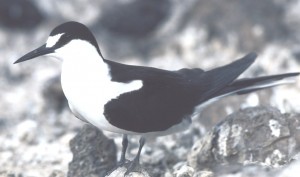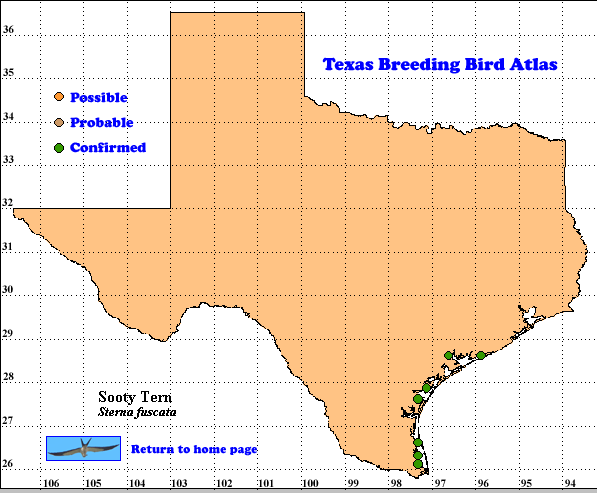Of the 7 species of terns for which breeding evidence was found by the TBBA project, only Sooty Terns are truly pelagic, spending more than half of their lives at sea. They inhabit tropical and subtropical oceas worldwide, coming to land only to breed. Front views of flying Sooty Terns show their long wings, emphasizing their structural resemblance to other pelagic birds such as albatrosses. While other terns often plunge-dive from heights, going underwater to catch small fish, Sooty Terns away from coast-lines can not fully submerge as they have no place to land and dry their plumage. Flying while carrying much water in their plumage takes more energy than these terns can afford. Instead, flocks of Sooty Terns and other birds like Wedge-tailed Shearwaters (Puffinus pacificus) use tactics such as flying low over schools of predatory fish like tuna and snatching small fish that leap out of water to avoid the predatory fish (Schreiber et al. 2002).
DISTRIBUTION. During the 1987-1992 field work seasons of the TBBA project, observers found 24 confirmed breeding sites for Sooty Terms along the central and south sections of the Texas coast in the Coastal Prairies, Coastal Sand Plain and South Texas Brush Country regions (see the region map in Lockwood and Freeman [2004]). Elsewhere in the New World these terns breed in the Hawaiian Islands and the Dry Tortugas at the end of the Florida Keys (Schreiber et al. 2002).
Worldwide Sooty Terns breed or have bren d on small, islands throughout tropical waters, including those off Mexico, Central and northern South America and the West Indies (Howell and Webb 1995, Schreiber et al. 2002).
SEASONAL OCCURRENCE. Sooty Terns are reported regularly in Texas from late March to early October. Breeding occurs between late April and early July, based on egg collection dates ranging from May 1 to June 15. Hurricanes sometimes blow these terns onto the coast and even far inland (Oberholser 1974, Lockwood and Freeman 2004).
BREEDING HABITAT. Sooty Terns breed along the coast on small islands (Oberholser 1974). These terns prefer to nest in small colonies above flood tides, in flat, sparsely vegetated, and fairly open areas. Where aerial predators are present, nests are often placed under shrubs or other vegetation. A shallow scrape may be dug or eggs may be laid on bare ground. Nests are usually placed at least 20 cm (8 in) from other nests in a colony. The typical clutch is one white to light buff egg, finely or coarsely spotted with dark brown. The parents share incubation for about 28-30 days. Sometimes parents add bits of vegetation or small pebbles to the nest during this period (Schreiber et al. 2002).
The semi-precocial chick is able to walk very soon after hatching. It is fed small fish and squid and on this diet takes 29 days to reach 90% of adult weight. Chicks can fly 8-10 weeks after hatching. After this the chicks leaves the colony each day, returning by evening to be fed by their parents. About 3 weeks later parents and their chick leave the nesting island and spend 2-3 months together at sea before separating. After this all Sooty Terns remain at sea until they return to breed. While a few juveniles breed at 4 years, most start when 8-10 years old. Then about 1/3 breed annually while the rest breed irregularly (Schreiber et al. 2002).
STATUS. Although Sooty Terns once nested on Galveston Island, they are now restricted to the central and lower coasts where they are considered rare and local (Lockwood and Freeman 2004). The estimated worldwide population of 60-80 million, make Sooty Terns the most abundant seabird. These long-lived birds (as long as 34 years) have been extirpated by humans from a number of breeding islands through habitat degradation, egg-collecting and the introduction of predators (Schreiber et al. 2002).
Text by Robert C. Tweit (2009)
Literature cited.
Howell, S. N. G. and S. Webb. 1995. A guide to the birds of Mexico and northern Central America. Oxford University Press, New York.
Lockwood, M. W. and B. Freeman. 2004. The TOS handbook of Texas birds. Texas A&M University Press, College Station.
Oberholser, H. C. 1974. The bird life of Texas. University of Texas Press, Austin.
Schreiber, E. A., C. J. Feare, B. A. Harrington, B. G. Murray, Jr., W. B. Robertson, Jr., M. J. Robertson and G. E. Woolfenden. 2002. Sooty Tern (Sterna fuscata), The Birds of North America Online (A. Poole, Ed.). Cornell Lab of Ornithology; Ithaca, NY. Retrieved from: http://bna.birds.cornell.edu/bna/species/665

